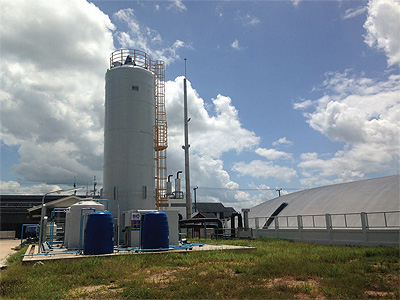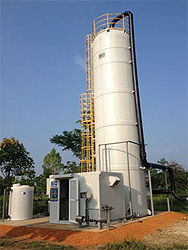
Biogasclean A/S
The key to efficient and successful utilisation of biogas
Founded in 2008, Biogasclean A/S is a Danish company specialised in the desulfurisation of biogas. The company develops, manufactures and markets fully automated gas-cleaning systems for H2S removal that ensure low operating costs and high levels of availability. In only a few short years, Biogasclean has established a solid and proven track record and today the company is able to boast as many as more than 200 plants in operation or under construction. These are located in 38 countries globally and supply clean gas to in excess of 475 MW gas engines.
Biogasclean supplies a complete range of biological H2S removal systems ranging from small gas cleaners to the world’s largest biological gas cleaners at ethanol distilleries and paper mills. The smallest systems can be loaded on a truck or shipped worldwide in one forty feet container. The largest systems comprise one or more tanks constructed on site as the diameter is too big for road transportation. The gas cleaners can be designed according to the client’s requirements to handle any flow rate and concentration of H2S content in raw biogas. During typical operation H2S is  reduced to 100-250 ppm, however Biogasclean can reduce this level to lower values as needed. The cleaning process is 100 per cent biological, with operating costs ranging from between 80 and 90 per cent lower than chemical gas cleaning systems and a level of availability of above 98 per cent. Additionally, the only residue from the process is a valuable liquid fertilizer.
reduced to 100-250 ppm, however Biogasclean can reduce this level to lower values as needed. The cleaning process is 100 per cent biological, with operating costs ranging from between 80 and 90 per cent lower than chemical gas cleaning systems and a level of availability of above 98 per cent. Additionally, the only residue from the process is a valuable liquid fertilizer.
A gas cleaner from Biogasclean comprises the following main systems: 1) The Process Technique Unit (the PTU) 2) One or more tanks and 3) Packing media. The PTU is the machine room and contained in a custom built fibreglass housing or modified shipping container or alternatively skid mounted. The PTU acts as the system’s control centre with a programmable logic controller (PLC) board, circulation pump, air blower, valves, flow metres and – if required – also a heating system. The PTU’s are assembled and tested at Biogasclean’s workshop before shipment. The tanks are made of reinforced fibreglass and are – except for the very large tanks constructed on site – manufactured at a workshop with filament winding machines. To reduce the cost of larger units, Biogasclean manufactures fibreglass tanks in several countries. The packing media is manufactured in plastic and houses the bacteria which oxidise the H2S to sulfate and elemental sulfur.
One of the most remarkable key features of the company’s product line is the QSR® – Quick Sludge Removal – system. During QSR® cleaning the tank is filled with water and pressurised air injected in the bottom of the tank so the packing media is washed like in a big washing machine. The QSR® system makes it possible to clean the tank without emptying the tank for packing media as in other biological scrubbers. It reduces down time during cleaning and gives the highest availability.
All of the systems offer the shared characteristics of high levels of safety, automatic operation, low operating costs and guaranteed performance. Indeed, the injection of air into biogas is only safe when a reliable control system is present. The PLC receives signals from an oxygen meter and can reduce or stop air injection entirely in the case that the oxygen content of the clean gas becomes too high. Furthermore, the safety system is designed to remove the source of ignition by cutting the system’s power supply if the gas detector in an enclosed PTU measures above 25 per cent of the lower explosive level. The PLC controller board also automatically controls the overall biogas cleaning system, which reduces the risk for manual errors and operational problems. The core function of the PLC is to ensure safe, optimal and sustainable conditions for the biological process. The signals sent by the PLC are made available to plant operators in the control room.
Biogasclean systems deliver low operating costs because they use no chemicals and have a very low level of electrical consumption. In many projects the company employs treated water  from an anaerobic digester or an aeration pond as scrubber liquid as well as nutrient source, which is readily available and more costeffective than soft water and industrial fertilizer. In order to prevent clogging inside the scrubber tank the treated water is first pre-treated with sulphate from the biological process in make-upwater (MUW) tanks. During the pre-treatment process calcium and magnesium react with the sulfate and settle in the MUW tanks before the water is finally pumped into the scrubber tank.
from an anaerobic digester or an aeration pond as scrubber liquid as well as nutrient source, which is readily available and more costeffective than soft water and industrial fertilizer. In order to prevent clogging inside the scrubber tank the treated water is first pre-treated with sulphate from the biological process in make-upwater (MUW) tanks. During the pre-treatment process calcium and magnesium react with the sulfate and settle in the MUW tanks before the water is finally pumped into the scrubber tank.
As the global energy market continues to look for reliable forms of clean fuel, biogas represents a renewable source of energy derived from organic waste streams. Its is a natural byproduct from anaerobic digestion of organic waste streams at livestock farms, food processing plants, breweries, palm oil mills, starch factories, ethanol distilleries, paper mills and other waste water treatment plants. In terms of its use as a renewable source of energy, biogas contains between 50-70 per cent methane (CH4), 30-50 per cent carbon dioxide (CO2) and 0.1-3 per cent hydrogen sulphide (H2S). When the H2S is removed from biogas it can be used to substitute oil and gas as a source of power and heat production or further upgraded to natural gas quality.
Biogasclean understands the importance of biogas as a renewable energy source for the future and has provided products to clients on every continent globally. “The most important market for Biogasclean is Southeast Asia and we have recently expanded our production facilities in Thailand,” adds Thorkil Dahlgreen, CEO. Over the coming years its innovative biological hydrogen sulphide scrubbers will continue to grow in presence throughout the world’s energy market.
Biogasclean A/S
Services: Manufactures and markets biological hydrogen sulphide scrubbers